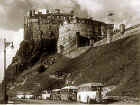Edinburgh - The Castle Above is a stereo view card by Douglas. The description on the back of this card reads: The most striking object in the City is the Castle, which is separated from the buildings of the High Street by a piece of open level ground of about 350 feet square, and is inaccessible on all the other sides. The area on which the castle is built is about seven acres. It is elevated nearly 300 feet above the level of the sea; but notwithstanding its height, it is commanded by the ground on almost every side. There are numerous cannon on the balls, and an armoury, which can contain 30,000 stand of arms. About 2,000 men can be accommodated. Barracks were built about fifty years ago, but by an injudicious style of architecture, they greatly impair the imposing aspect of the fortress. Here is also a Crown Room, where the Regalia of Scotland is deposited. The earliest name by which the castle is recognised in history is Castrum Puellarum, or Camp of the Maidens, from the daughters of the Pictish Kings being educated and brought up within its walls. The room where Queen Mary gave birth to James VI, on whom the Crowns of England were united, is an object of interest to strangers. In earlier periods of Scottish history, this fortress was often taken and retaken by conflicting parties. Among the more striking events in its annals may be mentioned that in 1296, during the contest between Bruce and Baliol, it was taken by the English; in 1333 its fortifications were demolished by Bruce; and during the reign of Queen Mary it was gallantly defended by Kirkcaldy of Grange for her, for which he was hanged by the Regent at the Cross of Edinburgh. In 1650, it was besieged by Cromwell, to whom it surrendered; and, in 1745, Prince Charles Stuart, although master of the City did not attempt its reduction. Facing the north-east is the half-moon Battery, mounted with twelve, eighteen and twenty-four ponders. From various parts of the fortification magnificent views of the City and its surrounding country may be obtained.
|
|
Please click here to see more views of Edinburgh Castle. |
|
Please click here to see maps of Edinburgh including Edinburgh Castle. |


